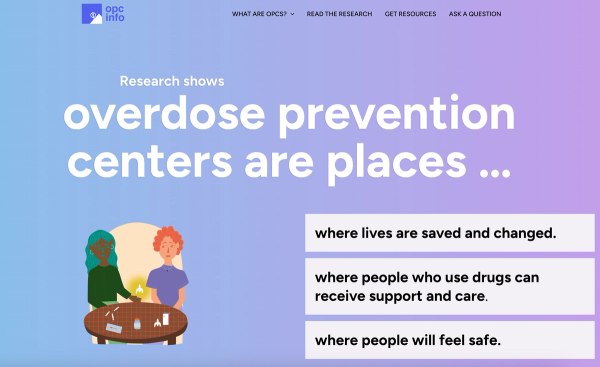OPC info: A new online resource on overdose prevention centres
OPC info is a resource with analysis and a database of papers published on overdose prevention centers (also known as: safe injection sites, safe consumption sites, drug consumption rooms). Users can sort by year and category or use search function to find a specific paper.
What are overdose prevention centers?
Overdose prevention centers (OPCs) (sometimes called safe consumption sites, safe injection sites or drug consumption rooms) are safe, monitored spaces where people can use their own drugs. In OPCs, trained staff can use naloxone (an overdose reversal medication) and oxygen to reverse an overdose and save a life, without needing to call 911.
These sites also provide new, safe supplies (pipes, cookers, etc.) to reduce the risk of infection and disease, by preventing the need to share or reuse equipment.
People can also test their drugs here to find out what may be in them. People can also get connected to services like healthcare, drug treatment, recovery programs, and housing at these sites.
Importantly, OPCs provide people with a supportive and safe environment, safe from stigma and judgment.
Why do we need overdose prevention centers?
Since 2017, more than 400,000 people have died of a drug-related overdose. The COVID-19 pandemic made the overdose crisis worse, with more than 100,000 people dying of an overdose in 2021. 2 Many overdoses are caused by powerful synthetic opioids like fentanyl. Fentanyl is often mixed into other drugs, including pills purchased off the street, cocaine, and meth.
The overdose crisis impacts everyone in the United States. Whether you live in Baton Rouge or Los Angeles, you likely know someone who has been affected by this public health crisis. Overdose deaths affect us all regardless of race and ethnicity, age, gender, or location. The crisis is getting worse for everyone.
Still, death rates can vary and groups are affected differently. In the last few years, for example, overdose death rates have increased the most for Black men. Indigenous people also face some of the highest overdose death rates in the country.
The War On Drugs Has Failed.
For over 50 years, we have tried to arrest our way out of this problem through the War on Drugs. We have spent $1 trillion dollars and every 25 seconds someone is arrested for possessing drugs in the United States. In 2019 for instance, there were more arrests for possession of drugs than for any other reason and these arrests have significant racial disparities. Yet deaths continue to climb. Why?
It’s because this approach makes it harder for people to get help and access services because they are afraid of being arrested. 6 This means people might not call 911 if they see someone overdose, or they may use drugs in ways that aren’t safe. We also know incarceration increases the risks of overdose. People are continuing to die. We need new approaches.
